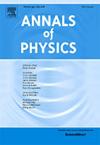作为引力规范理论的共形几何:协变运动方程和守恒定律
IF 3
3区 物理与天体物理
Q2 PHYSICS, MULTIDISCIPLINARY
引用次数: 0
摘要
我们将Weyl共形几何作为Weyl群(poincar本文章由计算机程序翻译,如有差异,请以英文原文为准。
Conformal geometry as a gauge theory of gravity: Covariant equations of motion & conservation laws
We study Weyl conformal geometry as a general gauge theory of the Weyl group (of Poincaré and dilatations symmetries) in a manifestly Weyl gauge covariant formalism in which this geometry is automatically metric and physically relevant. This gives a realistic (quadratic) gauge theory of gravity, with Einstein–Hilbert gravity recovered in its spontaneously broken phase, motivating our interest in this geometry. For the most general action we compute the manifestly Weyl gauge covariant equations of motion and present the conservation laws for the energy–momentum tensor and Weyl gauge current. These laws are valid both in Weyl conformal geometry (with respect to the Weyl gauge covariant derivative) but also in the Riemannian geometry equivalent picture (with respect to its associated covariant derivative). This interesting result is a consequence of gauged diffeomorphism invariance of the former versus usual diffeomorphism invariance of the latter. These results are first derived in dimensions. We then successfully derive the conservation laws and equations of motion in Weyl conformal geometry in arbitrary dimensions, while maintaining manifest Weyl gauge invariance/covariance. The results are useful in physical applications with this symmetry.
求助全文
通过发布文献求助,成功后即可免费获取论文全文。
去求助
来源期刊

Annals of Physics
物理-物理:综合
CiteScore
5.30
自引率
3.30%
发文量
211
审稿时长
47 days
期刊介绍:
Annals of Physics presents original work in all areas of basic theoretic physics research. Ideas are developed and fully explored, and thorough treatment is given to first principles and ultimate applications. Annals of Physics emphasizes clarity and intelligibility in the articles it publishes, thus making them as accessible as possible. Readers familiar with recent developments in the field are provided with sufficient detail and background to follow the arguments and understand their significance.
The Editors of the journal cover all fields of theoretical physics. Articles published in the journal are typically longer than 20 pages.
 求助内容:
求助内容: 应助结果提醒方式:
应助结果提醒方式:


